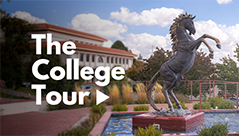“An inspirational showcase of our professors’ artwork” is how Expressive Arts major Charlee Alexander described the new exhibition of work by WNMU faculty on display at the McCray Gallery of Contemporary Art. “It is fantastic to see all of the faculty collaborating on something,” she said, “The community of the [Expressive] Arts Department is a really tight-knit, loving community, and all the professors are there to support each other’s work, as they do their students.”
The exhibition, which opened with a reception on October 19, features the work of seven members of the Department of Expressive Arts.
Professor of Sculpture and Department Chair Michael Metcalf exhibited cast bronze sculptures as well as a slyly humorous performance piece designed specifically for the opening reception of the exhibition. This piece, titled “Melting Head,” featured a head carved of wax that was previously used to create the mold for a cast bronze self-portrait. The head was placed in an electric frying pan that was turned on for the reception, causing the wax to melt into a puddle. “Melting Head,” said Metcalf of his work, “is about the dissolving of my role at WNMU after 28 and a half years. . . That head is going to go in that wax [at the bottom of the pan], and in the wax there is a history of what that head was, but it is gone; it is lost.
Metcalf is currently working on a large-scale sculpture commissioned by the university that will be installed on the Old James Stadium field.
Professor of Photography Jim Pendergast, who is currently on sabbatical and was consequently not in attendance, displayed a collection of photographs titled “Light Catcher,” taken at the Eureka Dunes in a remote valley that is part of Death Valley National Park. “Light Catcher,” Pendergast said, “is not simply a series of images of the Eureka Dunes; rather, it is a contemplation of light and how light plays across the lines and shapes of the dunes.”
In its own way, the work of Associate Professor of Ceramics Courtney Michaud is also concerned with light, which can be seen especially in her use of innovative glazes. Part of the work she displayed was a collection titled “New Moon Bowls.” The large, footed bowls, made of white stoneware and luster, had a matte black surface sprinkled with variously-sized luster dots, evocative of the constellations. “They are obviously reflective of the incredible night skies we get here [in New Mexico],” said Michaud, “The literal shape of the object reflects the 360-degree view we get.”
“Oftentimes, my work represents moments when I can feel connected in the world and singular at the same time,” said Michaud, “so for me that happens in nature.”
Assistant Professor of Graphic Design Ed Brandt, who displayed three-dimensional multimedia work, such as skateboards, in addition to wall-hung prints and a painting, said that his work explored the space between graphic design and fine art. “What is graphic design?,” he asked rhetorically, “It is described as visual communication. What is fine art? It is the idea that you are trying to communicate through visual arts.” Brandt said that he has struggled with the idea that the two fields are separate disciplines, and that this struggle was reflected in his work.
“You can find design beauty in the fine arts, and you can find some really intellectual conversations happening in graphic design,” said Brandt.
Four of the pieces that Assistant Professor of Painting and Drawing Matt Drissel displayed, part of a larger series titled “Domestic Disturbance,” were made with black walnuts that Drissell collected from around his house in Iowa, where he lived prior to relocating to Silver City. Drissell crushed the walnuts onto watercolor paper with his minivan, then added drawings made with walnut ink. “A lot of what I am doing with my works,” said Drissell, “is really trying to find ways to enjoy materials, to play around with them, but also to root those works in the specific place where I am.”
Drissell’s more recent work, a series of drawings that he then overglazes with bright and contrasting oil paint, “suggest a growing awareness of the Southwest’s striking complexities,” he stated.
Assistant Professor of Sculpture Erin Wheary, who joined the Department of Expressive Arts this fall, exhibited a mixed-media collection of photographs and sculptures documenting and evoking site-specific sculptural installations that she created during an artist’s residency in France. “For this series,” she said, “one hundred custom made boxes were stacked into walls barricading walkways and then systematically destroyed.”
Hugh Remar, who is a post-baccalaureate student in ceramics at WNMU, said that what he finds impressive about Wheary’s work is how she is “reimagining through photography a really large-scale sculptural work. She is able to reinterpret it in this gallery space, so we are seeing images of something in a space but then we are seeing it again in the real space.”
Remar’s comment is consistent with how Wheary herself explains her work. “The circular process of the project encourages observation,” she said.
The faculty exhibition will be on display at the McCray Gallery until November 16.



